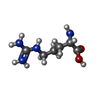+ Open data
Open data
- Basic information
Basic information
| Entry | Database: PDB / ID: 4ud9 | ||||||||||||
|---|---|---|---|---|---|---|---|---|---|---|---|---|---|
| Title | Thrombin in complex with 5-chlorothiophene-2-carboxamide | ||||||||||||
 Components Components |
| ||||||||||||
 Keywords Keywords | HYDROLASE / HYDROLASE INHIBITOR COMPLEX / SERINE PROTEASE / BLOOD COAGULATION / BLOOD CLOTTING / CONVERTION OF FIBRINOGEN TO FIBRIN / BLOOD CLOTTING INHIBITOR / THROMBIN INHIBITOR / FRAGMENT / GLYCOSYLATION / BLOOD | ||||||||||||
| Function / homology |  Function and homology information Function and homology informationcytolysis by host of symbiont cells / thrombospondin receptor activity / Defective factor XII causes hereditary angioedema / thrombin / thrombin-activated receptor signaling pathway / negative regulation of astrocyte differentiation / regulation of blood coagulation / neutrophil-mediated killing of gram-negative bacterium / positive regulation of phospholipase C-activating G protein-coupled receptor signaling pathway / Defective F8 cleavage by thrombin ...cytolysis by host of symbiont cells / thrombospondin receptor activity / Defective factor XII causes hereditary angioedema / thrombin / thrombin-activated receptor signaling pathway / negative regulation of astrocyte differentiation / regulation of blood coagulation / neutrophil-mediated killing of gram-negative bacterium / positive regulation of phospholipase C-activating G protein-coupled receptor signaling pathway / Defective F8 cleavage by thrombin / Platelet Aggregation (Plug Formation) / ligand-gated ion channel signaling pathway / positive regulation of collagen biosynthetic process / negative regulation of platelet activation / negative regulation of blood coagulation / positive regulation of blood coagulation / negative regulation of fibrinolysis / regulation of cytosolic calcium ion concentration / Transport of gamma-carboxylated protein precursors from the endoplasmic reticulum to the Golgi apparatus / Gamma-carboxylation of protein precursors / Common Pathway of Fibrin Clot Formation / Removal of aminoterminal propeptides from gamma-carboxylated proteins / fibrinolysis / Intrinsic Pathway of Fibrin Clot Formation / negative regulation of proteolysis / negative regulation of cytokine production involved in inflammatory response / Peptide ligand-binding receptors / Regulation of Complement cascade / positive regulation of release of sequestered calcium ion into cytosol / acute-phase response / Cell surface interactions at the vascular wall / positive regulation of receptor signaling pathway via JAK-STAT / growth factor activity / serine-type endopeptidase inhibitor activity / lipopolysaccharide binding / positive regulation of insulin secretion / platelet activation / response to wounding / positive regulation of protein localization to nucleus / Golgi lumen / Regulation of Insulin-like Growth Factor (IGF) transport and uptake by Insulin-like Growth Factor Binding Proteins (IGFBPs) / positive regulation of reactive oxygen species metabolic process / blood coagulation / antimicrobial humoral immune response mediated by antimicrobial peptide / regulation of cell shape / heparin binding / : / Thrombin signalling through proteinase activated receptors (PARs) / positive regulation of cell growth / blood microparticle / G alpha (q) signalling events / cell surface receptor signaling pathway / positive regulation of phosphatidylinositol 3-kinase/protein kinase B signal transduction / receptor ligand activity / endoplasmic reticulum lumen / signaling receptor binding / serine-type endopeptidase activity / positive regulation of cell population proliferation / calcium ion binding / proteolysis / extracellular space / extracellular exosome / extracellular region / plasma membrane Similarity search - Function | ||||||||||||
| Biological species |  Homo sapiens (human) Homo sapiens (human) Hirudo medicinalis (medicinal leech) Hirudo medicinalis (medicinal leech) | ||||||||||||
| Method |  X-RAY DIFFRACTION / X-RAY DIFFRACTION /  SYNCHROTRON / SYNCHROTRON /  MOLECULAR REPLACEMENT / Resolution: 1.124 Å MOLECULAR REPLACEMENT / Resolution: 1.124 Å | ||||||||||||
 Authors Authors | Ruehmann, E. / Heine, A. / Klebe, G. | ||||||||||||
 Citation Citation |  Journal: J.Med.Chem. / Year: 2015 Journal: J.Med.Chem. / Year: 2015Title: Fragments Can Bind Either More Enthalpy or Entropy-Driven: Crystal Structures and Residual Hydration Pattern Suggest Why. Authors: Ruehmann, E. / Betz, M. / Heine, A. / Klebe, G. | ||||||||||||
| History |
| ||||||||||||
| Remark 700 | SHEET DETERMINATION METHOD: DSSP THE SHEETS PRESENTED AS "HB" IN EACH CHAIN ON SHEET RECORDS BELOW ... SHEET DETERMINATION METHOD: DSSP THE SHEETS PRESENTED AS "HB" IN EACH CHAIN ON SHEET RECORDS BELOW IS ACTUALLY AN 6-STRANDED BARREL THIS IS REPRESENTED BY A 7-STRANDED SHEET IN WHICH THE FIRST AND LAST STRANDS ARE IDENTICAL. |
- Structure visualization
Structure visualization
| Structure viewer | Molecule:  Molmil Molmil Jmol/JSmol Jmol/JSmol |
|---|
- Downloads & links
Downloads & links
- Download
Download
| PDBx/mmCIF format |  4ud9.cif.gz 4ud9.cif.gz | 197.4 KB | Display |  PDBx/mmCIF format PDBx/mmCIF format |
|---|---|---|---|---|
| PDB format |  pdb4ud9.ent.gz pdb4ud9.ent.gz | 157.7 KB | Display |  PDB format PDB format |
| PDBx/mmJSON format |  4ud9.json.gz 4ud9.json.gz | Tree view |  PDBx/mmJSON format PDBx/mmJSON format | |
| Others |  Other downloads Other downloads |
-Validation report
| Summary document |  4ud9_validation.pdf.gz 4ud9_validation.pdf.gz | 513.4 KB | Display |  wwPDB validaton report wwPDB validaton report |
|---|---|---|---|---|
| Full document |  4ud9_full_validation.pdf.gz 4ud9_full_validation.pdf.gz | 513.9 KB | Display | |
| Data in XML |  4ud9_validation.xml.gz 4ud9_validation.xml.gz | 16.8 KB | Display | |
| Data in CIF |  4ud9_validation.cif.gz 4ud9_validation.cif.gz | 25 KB | Display | |
| Arichive directory |  https://data.pdbj.org/pub/pdb/validation_reports/ud/4ud9 https://data.pdbj.org/pub/pdb/validation_reports/ud/4ud9 ftp://data.pdbj.org/pub/pdb/validation_reports/ud/4ud9 ftp://data.pdbj.org/pub/pdb/validation_reports/ud/4ud9 | HTTPS FTP |
-Related structure data
| Related structure data | 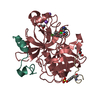 4udwC  4ue7C 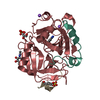 4uehC 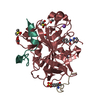 5af9C  5afyC 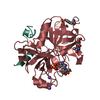 5afzC 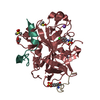 5ahgC  1h8dS  4udh C: citing same article ( S: Starting model for refinement |
|---|---|
| Similar structure data |
- Links
Links
- Assembly
Assembly
| Deposited unit | 
| ||||||||
|---|---|---|---|---|---|---|---|---|---|
| 1 |
| ||||||||
| Unit cell |
| ||||||||
| Components on special symmetry positions |
|
- Components
Components
-Protein/peptide , 2 types, 2 molecules IL
| #2: Protein/peptide | Mass: 1548.580 Da / Num. of mol.: 1 / Source method: obtained synthetically / Details: HIRUDIN (54-65) (SULFATED) / Source: (synth.)  Hirudo medicinalis (medicinal leech) / References: UniProt: P28504, UniProt: P09945*PLUS Hirudo medicinalis (medicinal leech) / References: UniProt: P28504, UniProt: P09945*PLUS |
|---|---|
| #3: Protein/peptide | Mass: 3317.741 Da / Num. of mol.: 1 / Fragment: THROMBIN LIGHT CHAIN, UNP RESIDUES 333-360 / Source method: isolated from a natural source / Details: PURIFIED FROM HUMAN BLOOD PLASMA / Source: (natural)  Homo sapiens (human) / References: UniProt: P00734, thrombin Homo sapiens (human) / References: UniProt: P00734, thrombin |
-Protein / Sugars , 2 types, 2 molecules H

| #10: Sugar | ChemComp-NAG / |
|---|---|
| #1: Protein | Mass: 29780.219 Da / Num. of mol.: 1 / Fragment: THROMBIN HEAVY CHAIN, UNP RESIDUES 364-622 / Source method: isolated from a natural source / Details: PURIFIED FROM HUMAN BLOOD PLASMA / Source: (natural)  Homo sapiens (human) / References: UniProt: P00734, thrombin Homo sapiens (human) / References: UniProt: P00734, thrombin |
-Non-polymers , 7 types, 302 molecules 

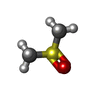


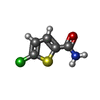







| #4: Chemical | | #5: Chemical | ChemComp-PO4 / | #6: Chemical | #7: Chemical | #8: Chemical | #9: Chemical | ChemComp-FQI / | #11: Water | ChemComp-HOH / | |
|---|
-Details
| Has protein modification | Y | ||
|---|---|---|---|
| Nonpolymer details | 5-CHLORO-2-THIOPHENEC| Sequence details | ASP 14L WAS NOT BUILD DUE TO LACK OF ELECTRON DESITY RESIDUES 149B-149E WERE NOT BUILD DUE TO LACK ...ASP 14L WAS NOT BUILD DUE TO LACK OF ELECTRON DESITY RESIDUES 149B-149E WERE NOT BUILD DUE TO LACK OF ELECTRON DESITY | |
-Experimental details
-Experiment
| Experiment | Method:  X-RAY DIFFRACTION / Number of used crystals: 1 X-RAY DIFFRACTION / Number of used crystals: 1 |
|---|
- Sample preparation
Sample preparation
| Crystal | Density Matthews: 2.5 Å3/Da / Density % sol: 50.8 % / Description: NONE |
|---|---|
| Crystal grow | pH: 7.5 Details: SEE MATERIALS AND METHODS SECTION OF PUBLICATION, pH 7.5 |
-Data collection
| Diffraction | Mean temperature: 113 K |
|---|---|
| Diffraction source | Source:  SYNCHROTRON / Site: SYNCHROTRON / Site:  PETRA III, EMBL c/o DESY PETRA III, EMBL c/o DESY  / Beamline: P14 (MX2) / Wavelength: 0.976 / Beamline: P14 (MX2) / Wavelength: 0.976 |
| Detector | Type: DECTRIS PILATUS 6M / Detector: PIXEL / Date: Nov 14, 2013 |
| Radiation | Protocol: SINGLE WAVELENGTH / Monochromatic (M) / Laue (L): M / Scattering type: x-ray |
| Radiation wavelength | Wavelength: 0.976 Å / Relative weight: 1 |
| Reflection | Resolution: 1.12→35.7 Å / Num. obs: 127839 / % possible obs: 96.7 % / Observed criterion σ(I): 3.1 / Redundancy: 6.3 % / Biso Wilson estimate: 12.65 Å2 / Rmerge(I) obs: 0.04 / Net I/σ(I): 21.8 |
| Reflection shell | Resolution: 1.12→1.16 Å / Redundancy: 4.2 % / Rmerge(I) obs: 0.41 / Mean I/σ(I) obs: 3.11 / % possible all: 76.3 |
- Processing
Processing
| Software |
| |||||||||||||||||||||||||||||||||||||||||||||||||||||||||||||||||||||||||||||||||||||||||||||||||||||||||||||||||||||||||||||||||||||||||||||||||||||||||||||||||||||||||||||||||||||||||||||||||||||||||||||||||||||||||
|---|---|---|---|---|---|---|---|---|---|---|---|---|---|---|---|---|---|---|---|---|---|---|---|---|---|---|---|---|---|---|---|---|---|---|---|---|---|---|---|---|---|---|---|---|---|---|---|---|---|---|---|---|---|---|---|---|---|---|---|---|---|---|---|---|---|---|---|---|---|---|---|---|---|---|---|---|---|---|---|---|---|---|---|---|---|---|---|---|---|---|---|---|---|---|---|---|---|---|---|---|---|---|---|---|---|---|---|---|---|---|---|---|---|---|---|---|---|---|---|---|---|---|---|---|---|---|---|---|---|---|---|---|---|---|---|---|---|---|---|---|---|---|---|---|---|---|---|---|---|---|---|---|---|---|---|---|---|---|---|---|---|---|---|---|---|---|---|---|---|---|---|---|---|---|---|---|---|---|---|---|---|---|---|---|---|---|---|---|---|---|---|---|---|---|---|---|---|---|---|---|---|---|---|---|---|---|---|---|---|---|---|---|---|---|---|---|---|---|
| Refinement | Method to determine structure:  MOLECULAR REPLACEMENT MOLECULAR REPLACEMENTStarting model: PDB ENTRY 1H8D Resolution: 1.124→35.681 Å / SU ML: 0.07 / σ(F): 1.36 / Phase error: 12.56 / Stereochemistry target values: ML
| |||||||||||||||||||||||||||||||||||||||||||||||||||||||||||||||||||||||||||||||||||||||||||||||||||||||||||||||||||||||||||||||||||||||||||||||||||||||||||||||||||||||||||||||||||||||||||||||||||||||||||||||||||||||||
| Solvent computation | Shrinkage radii: 0.9 Å / VDW probe radii: 1.11 Å / Solvent model: FLAT BULK SOLVENT MODEL | |||||||||||||||||||||||||||||||||||||||||||||||||||||||||||||||||||||||||||||||||||||||||||||||||||||||||||||||||||||||||||||||||||||||||||||||||||||||||||||||||||||||||||||||||||||||||||||||||||||||||||||||||||||||||
| Displacement parameters | Biso mean: 20.1 Å2 | |||||||||||||||||||||||||||||||||||||||||||||||||||||||||||||||||||||||||||||||||||||||||||||||||||||||||||||||||||||||||||||||||||||||||||||||||||||||||||||||||||||||||||||||||||||||||||||||||||||||||||||||||||||||||
| Refinement step | Cycle: LAST / Resolution: 1.124→35.681 Å
| |||||||||||||||||||||||||||||||||||||||||||||||||||||||||||||||||||||||||||||||||||||||||||||||||||||||||||||||||||||||||||||||||||||||||||||||||||||||||||||||||||||||||||||||||||||||||||||||||||||||||||||||||||||||||
| Refine LS restraints |
| |||||||||||||||||||||||||||||||||||||||||||||||||||||||||||||||||||||||||||||||||||||||||||||||||||||||||||||||||||||||||||||||||||||||||||||||||||||||||||||||||||||||||||||||||||||||||||||||||||||||||||||||||||||||||
| LS refinement shell |
|
 Movie
Movie Controller
Controller



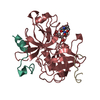
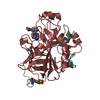
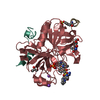
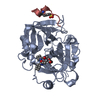
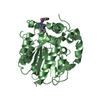
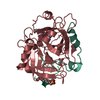
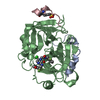
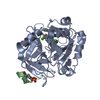

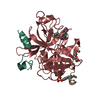

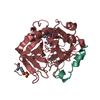
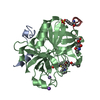
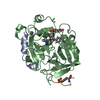
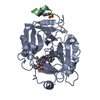
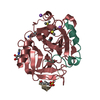
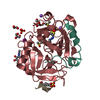


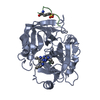
 PDBj
PDBj








